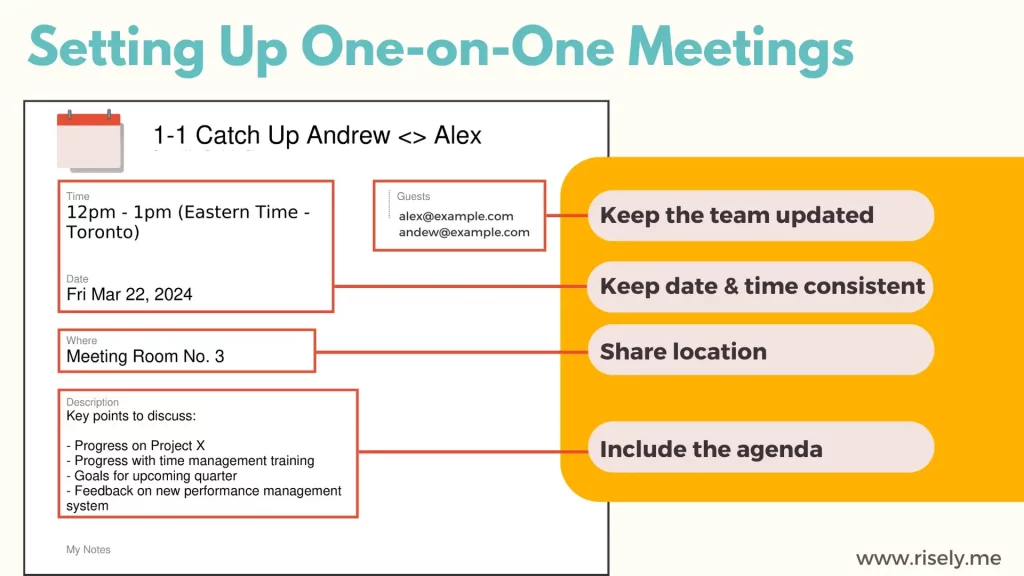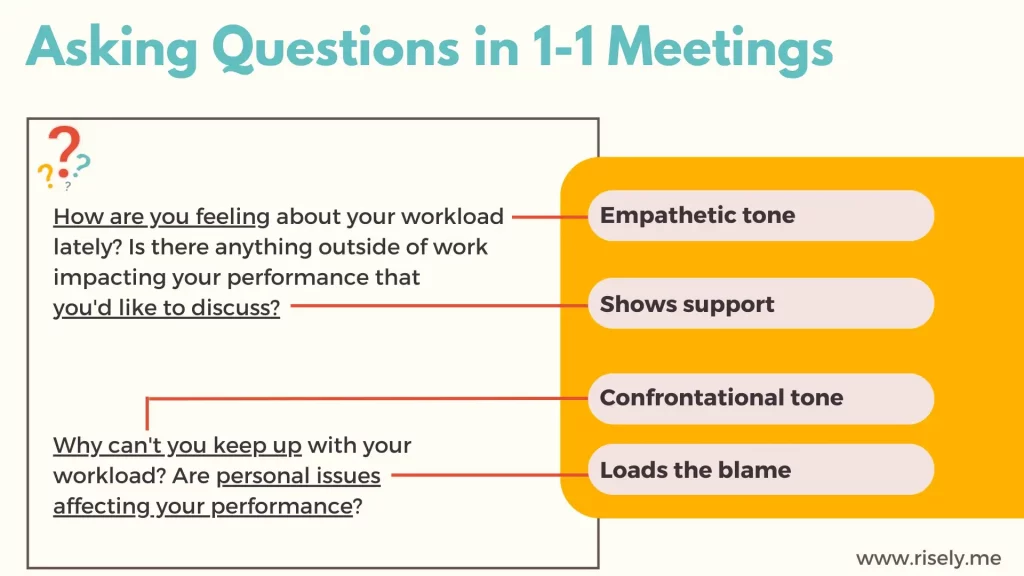One-on-one Meetings That Don’t Make Your Team Sigh
One-on-one meetings! If you are anywhere close to a performance review session, your calendar might be crowded by the team. But there’s more: most effective managers do not wait for performance reviews to knock before leading a one-on-one meeting. Instead, they consistently organize such review meetings with their team members. And the impact is palpable – managers who recognize the importance of solid one-on-one catch-ups are in sync with their team members. Their relationships go beyond the professional workspaces and develop into practical ways to connect. If you are here, undoubtedly, you want to join this league. So, let’s figure a way out to make your one-on-one meetings top notch!What is a one-on-one meeting?
Simply put, a one-on-one meeting is a conversation between a manager and an employee to get to know each other. The discussions can range from career progression to addressing concerns and providing support and coaching. All in all, they are an opportunity for the manager to show that they are present and willing to help while creating a safe space for the team member to share their thoughts. Remember, it’s a two-way conversation, not a critical monologue session. The focus should be on topics beyond work rather than on taking status updates.One-on-one conversations involve connecting emotionally and creating dedicated space and time for meaningful interactions. View these one-on-one conversations as a holistic approach that encompasses feedback but begins with establishing strong connections.Ashish Manchanda, Manager Story
But what’s the point? Why should you take one-on-one meetings seriously?
If you are thinking, why bother? Here are several incredible reasons to invest your time and energy in one-on-one meetings.- First, these meetings allow managers to gain deeper insights into their team members, aspirations and needs through attentive listening. They also help employees discuss things that don’t come up in shared and public spaces. By showcasing authenticity and vulnerability as a leader, you can empower your team to emulate.
- Second, it establishes you as a confidante and trustworthy supporter of your team members. When a manager creates a safe space and truly listens, it allows the team members to place trust and loyalty in them. Psychological safety is not a buzzword; it matters (high psychological safety takes the risk of turnover as low as 3%, as per BCG), and one-on-one help helps you create it big time.
- Third, it makes your working relationship super smooth. How easy is it to go to your manager and say you need some time for professional development? Pretty great, right? That’s what consistently keeping up with one-on-one meetings allows team members to do. It creates a working relationship free of facades and mutually focuses on developing the team and individual.
How to conduct one on one meetings?
Before heading on to crafting perfection, let’s look at what we typically miss: what makes a one-on-one meeting bad? Think of your own experiences. Did you ever have a one-on-one catch-up with that left you seething with anger, or worse – sad?Why do one-on-one meetings fail?
Here’s why it happens:People are different
It’s no surprise that people vary, and so does everything about them that is needed to build a solid working relationship. This includes their communication styles, personalities, ways of working, and much more. When these two don’t align, one-on-one meetings often become a competition or argument instead of a collaborative discussion.The manager tells without showing
Picture a one-on-one meeting going like this: a manager starts on a good note and urges their team member to be open and honest about everything – the good, bad, and the ugly. But on the flip side, the manager does not follow their word and shares little of their perspective. As a result, the team member does not get a concrete example of how vulnerability or authenticity can be expressed. Instead, they are left with something sinister – an unfulfilled promise and a space that makes them uncomfortable as they walk out of the meeting room while sighing and thanking themselves for not blurting out everything.The manager takes the lead
Heading into a one-on-one meeting with the attitude of a team meeting where you direct everyone to this or that backfires big time. It’s crucial to understand that one-on-one meetings are not a one-way channel to share your thoughts with a person. A manager’s role in a one-on-one meeting extends to facilitating their team to overcome hesitation and truly express their needs and thoughts. Focusing on listening, not speaking. Not asking questions, going ahead without an agenda, and not taking feedback from the team members are the most common problems in bad one-on-one meetings.Defensive behavior and high guards
Sometimes, one-on-one meetings could fail if the team members are not ready to open up and share their thoughts. After all, it takes two to clap. In such instances of defensive behavior from a team member, focus on building rapport with them and creating a sense of safety that helps them put their guard down. Initially, the process could be slow, but it ultimately leads to solid returns. Remember that personalities and communication styles vary, and accommodating them is necessary to create solid one-on-one relationships.Let’s think boundaries
We started by taking note of one-on-one meetings as something that creates a solid working relationship, one that is marked by authenticity and care on both sides. Yet the moment we head out of strict professional space, we walk along a delicate line – one where we, as managers, might end up encroaching into their personal lives. Criticism that goes to the person instead of the professional hurts the commitment to creating good relationships and safety at work. Hence, boundaries matter.Other Interesting Reads
How to structure one on one meetings?
The structure and frequency of one-on-one meetings are critical factors that differentiate them from other water cooler conversations. What else? The agenda, questions, and updates matter, too! Let’s use an example to see this one in action. We are heading into a one-on-one meeting with a manager named Andrew to see how it goes.What’s the process of good one-on-one meetings?
First, let’s focus on the structural things. Before heading into a meeting, we need to collect some ingredients:How to schedule one on one meetings?
Yep, we need to schedule a meeting before conducting one, unsurprisingly. Ideally, schedule the meeting a few days before it happens and do so at a regular cadence. Irregularity and lack of frequency can be a source of disappointment, as they show that the matter is not severe enough to give due thought and planning. The ideal cadence for one-on-one meetings depends on your context. While a manager new to the team should keep the frequency high, those dealing with senior reports need more time for in-depth discussions. Remote managers doing one-on-one meetings can take it up frequently to compensate for limited interactions. Team size matters too—after all, you can’t spend a week on one-on-ones alone! Moreover, your team will have something to say about it, so do take their opinions on the frequency of meetings. Managers hold one-on-one meetings weekly, bi-weekly, or monthly, depending on their team’s structure and needs. A monthly routine can be a great way to start—it gives enough time for developments to progress and enables reviews. Define a suitable time limit that does not take away from your team’s productivity while allowing a good discussion. Anywhere between 20 to 40 minutes is a good place to start. Once the meeting is set, we can move forward. While speaking of the frequency of one-on-one meetings, it’s essential to acknowledge that keeping them far away or canceling them at the last minute is a sure-shot red flag. If a meeting cannot happen, find an alternative to compensate for the lost chance at connecting; it shows that you care.
Defining the one-on-one meeting agenda
An agenda helps you set the tone and purpose of the meeting right from the start. One-on-one meetings can often falter because they seem like an unnecessary vanity exercise imposed by management. Having set agendas and topics to discuss can help you avoid that. Moreover, scheduling the meeting in advance allows your team members time to prepare and share their agendas and topics. Here’s how Andrew sets the agenda in our example one-on-one meeting with his team members:- Step 1: Add critical points to discuss along with the meeting invite. It helps the team members prepare and ensures them about the contents of the discussion, creating comfort.
- Step 2: When the meeting starts, clearly reiterate the agenda, like this: “Thanks for meeting with me today, Alex. I wanted to touch base on a few key points. First, let’s discuss your current projects and any challenges you’re facing. Then, I’d like to discuss your goals for the upcoming quarter. Lastly, we can address any support or resources you might need from me or the team. Does that sound good to you?“
- Step 3: Add Alex’s points to discuss in the meeting.
Talking progress in a one-on-one conversation
One focal point of a one-on-one meeting is discussing progress on the plans you made last time. In addition to work-related areas, you can discuss professional development and personal growth. For instance, your team member might have started a course on time management after you pointed out the need for more timeliness. Ask about it. It shows that you care and remember what’s happening with them. Here’s how Andrew asked Alex about her previous work: “How are things progressing with Project X? Are you on track to meet the milestones we set? I noticed you encountered some issues last week. Can you update me on how you’ve tackled those challenges?“ Keeping progress in mind also defines a routine for one-on-one meetings and keeps the conversation consistent. Consider taking notes to know what to ask in the next one. Forgetting is easier than we remember.
Using feedback in a one-on-one meeting
Constructive feedback is the cornerstone of growth and a crucial element of one-on-one catch-ups. As a manager, take some time to outline the critical areas where you want to share feedback. Keep the basics in mind: the feedback should be constructive, give it right in time, and help with the resources and support needed to implement it. Afterward, transfer it to the progress of your one-on-one conversation and keep moving. It can go like this: “I’ve been reviewing your recent work, and overall, I’m impressed with the quality and attention to detail. However, I noticed a few areas where there’s room for improvement, particularly in communicating updates to the team. Let’s work together to refine your approach.”- reinforces the positives directly
- highlights areas of improvement, specifically
- supports through the improvement needed
- does not tell what to improve or how
- the tone and language are threatening
- does not provide guidance
- Follow it up after a discussion: “Additionally, is there any feedback you have for me or areas where you think I can better support you?“
- Go specific if you feel the need: “Is there anything about our team’s communication that you find challenging?“
- 20+ Useful Performance Feedback Examples for Managers
- 10+ Positive Feedback Examples for Managers at Work
- 10+ Negative Constructive Feedback Examples to Use at Work
Building rapport in a one-on-one conversation
One-on-one meetings are your tools to bring candidness into the workspace. It fuels the team with positivity and care toward each other. Moreover, it’s your chance to build loyalty and gain support from your team members. Taking the time to check in on how the team member feels, address any concerns, and offer support that demonstrates empathy and strengthens the manager’s bond with the team member like Andrew does by asking this – “Before we wrap up, I’d like to check how you feel about your role and our team dynamics. How are you finding your workload lately? Is there anything outside of work impacting your performance that you’d like to discuss?“ Building rapport with your team members goes beyond discussing work-related matters and includes showing genuine interest in their well-being and professional development. For instance, Andrew asks Alex about her progress in guitar lessons.“I remember you mentioned your interest in learning guitar. Have you had a chance to practice that lately?“ And to make it even better, there’s something that Andrew adds –
“I used to play the guitar during my college days as a member of our band. Let me know if I can be of any help. It’s been a while since I picked it up.“ It creates a shared interest and relatability for the two to connect. Sometimes, your team members might be going through personal troubles that impact everywhere; you can become a source of empathy and reassurance. Focus on listening empathetically and providing guidance in suitable ways. Rapport building is not about ticking boxes; it’s about showing up and caring as your team needs you to. Sometimes, they might feel uncomfortable, especially when your team is new to one-on-one meetings. In such situations, take the lead and set the tone right. Don’t head in with tiredness; that will make your team members feel the same. Instead, push the energy you want the discussion to have. Keep your tone and demeanor open to conversation, and demonstrate friendliness with your body language. Don’t forget to keep your phone aside for a while and the conversation the attention it truly deserves.
How can you improve one-on-one meetings?
Now, you might think that you are doing everything right. You have a checklist of topics to discuss and exude your best energy, yet the catch-ups don’t seem right. You might not be seeing the other perspective. While managers and employees agree that one-on-one meetings are important, Hypercontext found a key area of disagreement: how well are the one-on-ones going? 72% of managers believed their employees were motivated after a discussion, but the number sinks to 58% when team members are asked. Does your team disagree similarly? You can find out with Risely! First, take the free one-on-one meeting skill assessment for managers here. It will give you a detailed analysis of the skills you need to conduct one-on-one meetings effectively. Second, ask your team to assess your one-on-one meeting skills. The best part is that this assessment is anonymous. You get a cumulative score representing what your team thinks, and their privacy is protected. Next, ask Merlin about it; Merlin is Risely’s AI coach, who is present 24*7 to help out managers who want to unleash their true potential, just like you! The first three conversations with Merlin are free here. Along with getting tips, you can practice discussions through role plays, where Merlin acts like your team members, and your conversations are reviewed.To Conclude
One-on-one meetings foster authentic relationships and trust between managers and team members. These meetings provide open communication, enabling managers to gain deeper insights into their team’s aspirations and concerns. By actively listening and giving support, managers can create a safe space where team members feel valued and empowered. Structuring these meetings with clear agendas and frequent check-ins reinforces their importance and facilitates meaningful discussions. Moreover, building rapport through genuine interest and empathy strengthens bonds and enhances the work environment. Ultimately, investing time and effort in one-on-one meetings cultivates a culture of collaboration, growth, and mutual respect within the team.Grab a free one-on-one meeting toolkit here!
Find valuable resources curated by experts including one-on-one meeting questions, frameworks, and much more.
Other Related Blogs
How to Set Effective Learning and Development Goals?
This blog highlights how effective learning and development goals are set, why is setting them important for your organization and what challenges you might face during this process. … Read…
Are you on track to meet your Q1 goals?
Are you on track to meet your Q1 goals? We are in the middle of the first quarter of 2024. Seems hard to believe. It surely is! ⏰ Time has…
5 Secrets Of Solid Goal Setting At Work You Can’t Miss
5 Secrets Of Solid Goal Setting At Work You Can’t Miss “I don’t focus on what I’m up against. I focus on my goals and I try to ignore the…
Understanding the world of Goal Setting Coach to reach new heights
Understanding the world of Goal Setting Coach to reach new heights Setting and achieving goals is essential for personal and organizational success in today’s fast-paced and competitive work environment. However,…


